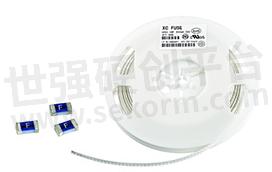How Does a Fuse Work?

We all know that when current flows through a conductor, it will generate heat due to the presence of a certain resistance in the conductor. And the calorific value follows this formula: Q=0.24I2RT; Where Q is the heat generated, 0.24 is a constant, I is the current flowing through the conductor, R is the resistance of the conductor, and T is the time for the current to flow through the conductor; Based on this formula, we can easily see the simple working principle of Shenzhen fuses. Once the material and shape of the fuse are determined, its resistance R is relatively determined (without considering its resistance temperature coefficient).
When current flows through a fuse, it will generate heat, and as time increases, its heat also increases. The magnitude of current and resistance determines the speed at which a fuse generates heat, while the construction and installation of a fuse determine the speed at which heat is dissipated. If the speed at which heat is generated is less than the speed at which heat is dissipated, the fuse will not blow. If the speed of heat generation is equal to the speed of heat dissipation, it will not fuse for a considerable period of time. If the speed of heat generation is greater than the speed of heat dissipation, then more and more heat will be generated. And because it has a certain specific heat and mass, the increase in heat is reflected in the increase in temperature. When the temperature rises above the melting point of the fuse, the fuse will blow. This is the working principle of a fuse.
We should know from this principle that when designing and manufacturing fuses, we must carefully study the physical properties of the materials you choose and ensure that they have consistent geometric dimensions. Because these factors play an important role in ensuring the normal operation of the fuse. Similarly, when using it, it is important to install it correctly. Ohm's Law: The current passing through a conductor is proportional to the voltage at both ends of the conductor and inversely proportional to the resistance value of the conductor. The basic formula is I=U/R.

Fig.1
- +1 Like
- Add to Favorites
Recommend
- Determine if the Fuse is Burning (Fuse)?
- The Difference between Fuses and Fuses
- Repair Methods for Fuses -0805 Fuses
- Very Fast Acting Fuse PICO® II Fuse Series, Designed for Battery Management System | Littelfuse
- Calculation Method for Melt Current of Fuse Fuses
- The Difference between Self Recovery Fuse and Blown Fuse
- The Location where the Fuse is Connected to the Circuit and Connection Method of Patch Fuse in Circuit
- Littelfuse expands its fuse manufacturing operation in China, Cuting Customer Order Fulfillment Lead Time by Half
This document is provided by Sekorm Platform for VIP exclusive service. The copyright is owned by Sekorm. Without authorization, any medias, websites or individual are not allowed to reprint. When authorizing the reprint, the link of www.sekorm.com must be indicated.














































































































































































































































































































































































































































































































































































































































































































































































































































